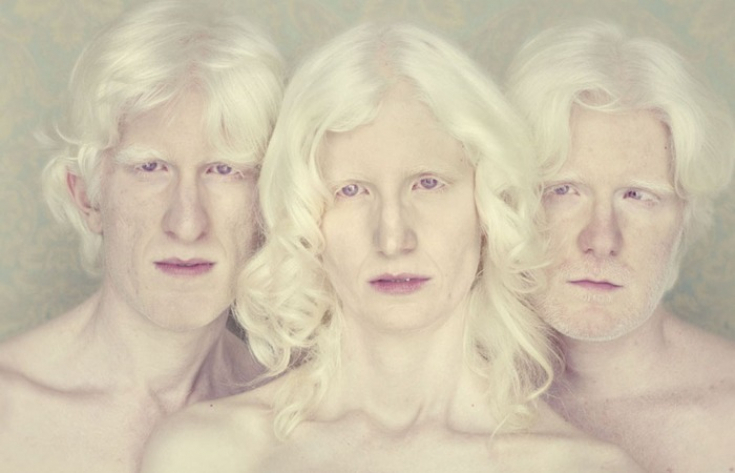Not so long ago, researchers discovered a tribe in Southern Panama whose name in translation meant "moon children", since they were all albinos and were predominantly nocturnal due to the fact that the sun burned their skin and blinded their eyes. The absence of pigment in the body and, in connection with this, the often reddish tint of the eyes, combined with unnaturally white skin, could in the Middle Ages be sufficient grounds for accusing a person of vampirism and witchcraft. But in essence, albinism in a person brings trouble only to himself.
Read on estet-portal.com about the signs, prevention, diagnosis and treatment options for albinism.
- Interesting facts about the disease
- Why does a person have albinism and how to recognize it
- The Troubles of Albinism
- Diagnostics and options for correcting the condition of in albinism
Interesting facts about the disease
Albinism is a genetic disease in which the human body lacks the pigment melanin, which gives color to the skin, hair, iris and pigment membranes of the eye.
More useful information on our Instagram page!
The very word "albino" was coined by the Portuguese Francisco Baltazar, the founder of Philippine literature. Calling "white" Africans so, the writer mistakenly believed that such people are born as a result of marriages of Europeans with local residents.

Signs of albinism have a strong enough effect on "ordinary" people who begin to perceive inadequately "colorless". So, in 2001 in the USA, Timothy White killed his colleague David Harrison. The man was so obsessed with stories about various monsters that he mistook Harrison for a vampire and shot the albino first in the face, and then in the stomach.
Why does a person have albinism and how to recognize it
Albinism is the genetically determined absence of the pigment melanin in the body, which is responsible for the color of the skin, hair, and some eye tissues.
Subscribe to our page on Facebook!

Albinism in a human can be:
- full – when there is no pigment in the body at all, in this condition, absolutely all the skin of a person is pale pink, eyelashes, eyebrows, hair are discolored, eyes are light blue or even reddish due to translucent vessels;
partial – when there is no pigment only in certain organs, for example, in hair, eyelashes, eyes.
- The reason for the development of albinism in humans is a genetic defect in which the synthesis of the tyrosinase enzyme is impaired, and the pigment melanin ceases to be produced or its synthesis is insufficient. This hereditary defect is transmitted in a recessive manner, often a woman is the carrier of the defective gene. She does not normally have albinism, but she may pass this genetic disorder on to her son.
slight outward signs of such a deviation:
freckles;
The main danger posed by albinism in humans – these are serious vision problems. It is not uncommon for a child with albinism to be born with only 5% vision. Lack of pigment leads to & nbsp; to photophobia, the patient complains that he cannot tolerate sunlight and can only see normally at dusk. In addition to nyctalopia, people with insufficient melanin production suffer from strabismus, nystagmus, and they often develop cataracts.The other problem of albinism
– this is a very high risk of malignant skin diseases, since it is exclusively & nbsp; sensitive to ultraviolet radiation, and a person with such pale skin is absolutely not protected from the effects of sunlight.In addition to the above, albinism entails increased dryness of the skin, impaired sweating, impaired body hair (increased or, conversely, reduced), reduced immunity, problems with childbearing.
Albinism in humans may be a manifestation of other diseases associated with genetic disorders – e.g. Angelman syndrome.Diagnostics and options for correcting the condition of albinism
Traditionally,albinism is classified into two broad categories:
1. Oculocutaneous Albinism (OCA).
Melanin is either absent or reduced in the hair, skin, and visual system. The danger lies in the fact that the lack of this pigment can provoke skin cancer.2. Ocular Albinism (HA).
Changes appear only in the visual system, skin and hair do not change color.

Albino people can have various vision problems:
nearsightedness or farsightedness may occur, there is a possibility of a defect in the lens;
-
there is a possibility of voluntary or constant movements of the eyeball, which are called nystagmus; -
Problems may occur that are related to eye coordination, tracking, and fixing the gaze on an object. Sometimes temporary or permanent strabismus develops.
In order to detect albinism, the doctor prescribes the following tests:
DNA genetic testing;
- electroretinogram;
- Chemical hair analysis.
- There are a sufficient number of genetic tests that allow you to diagnose a gene mutation, and to identify a deviation even before the baby is born. If there are suggestions about the likely carriage of a defective gene, it is worth discussing the possibility of childbearing with specialists in advance.
More useful information on our channel in
Youtube






Add a comment